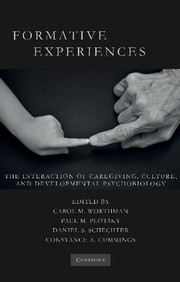Book contents
- Frontmatter
- Contents
- List of Figures
- List of Tables
- List of Contributors
- Foreword by Robert Sapolsky
- Preface
- List of Abbreviations
- Introduction
- SECTION ONE HISTORICAL, CROSS-CULTURAL, AND DEVELOPMENTAL SCIENCE PERSPECTIVES
- SECTION TWO HOW EXPERIENCE INTERACTS WITH BIOLOGICAL DEVELOPMENT
- SECTION THREE FORMATIVE RELATIONSHIPS WITHIN AND ACROSS GENERATIONS
- SECTION FOUR SOCIAL AND CULTURAL CONTEXTS OF CHILDHOOD DEVELOPMENT – NORMATIVE SETTINGS, PRACTICES, AND CONSEQUENCES
- 11 Ethnographic Case Study: Inuit Morality Play and the Danish Medical Officer
- Commentary
- Commentary
- 12 Ontogenetic Perspectives on the Neurobiological Basis of Psychopathology Following Abuse and Neglect
- 13 Ethnographic Case Study: Maria – Cultural Change and Posttraumatic Stress in the Life of a Belizean Adolescent Girl
- Commentary
- Commentary
- 14 Sex/Gender, Culture, and Development: Issues in the Emergence of Puberty and Attraction
- SECTION FIVE FEAR, FUN, AND THE BOUNDARIES OF SOCIAL EXPERIENCE
- SECTION SIX PUBLIC HEALTH, EDUCATION, AND POLICY IMPLICATIONS
- Index
- References
12 - Ontogenetic Perspectives on the Neurobiological Basis of Psychopathology Following Abuse and Neglect
Published online by Cambridge University Press: 26 May 2010
- Frontmatter
- Contents
- List of Figures
- List of Tables
- List of Contributors
- Foreword by Robert Sapolsky
- Preface
- List of Abbreviations
- Introduction
- SECTION ONE HISTORICAL, CROSS-CULTURAL, AND DEVELOPMENTAL SCIENCE PERSPECTIVES
- SECTION TWO HOW EXPERIENCE INTERACTS WITH BIOLOGICAL DEVELOPMENT
- SECTION THREE FORMATIVE RELATIONSHIPS WITHIN AND ACROSS GENERATIONS
- SECTION FOUR SOCIAL AND CULTURAL CONTEXTS OF CHILDHOOD DEVELOPMENT – NORMATIVE SETTINGS, PRACTICES, AND CONSEQUENCES
- 11 Ethnographic Case Study: Inuit Morality Play and the Danish Medical Officer
- Commentary
- Commentary
- 12 Ontogenetic Perspectives on the Neurobiological Basis of Psychopathology Following Abuse and Neglect
- 13 Ethnographic Case Study: Maria – Cultural Change and Posttraumatic Stress in the Life of a Belizean Adolescent Girl
- Commentary
- Commentary
- 14 Sex/Gender, Culture, and Development: Issues in the Emergence of Puberty and Attraction
- SECTION FIVE FEAR, FUN, AND THE BOUNDARIES OF SOCIAL EXPERIENCE
- SECTION SIX PUBLIC HEALTH, EDUCATION, AND POLICY IMPLICATIONS
- Index
- References
Summary
INTRODUCTION
The US Federal Child Abuse Prevention and Treatment Act defines child abuse and neglect as the recent act or failure of parents and caretakers resulting in physical or emotional injury, sexual exploitation, and/or death. According to national statistics on the prevalence of childhood abuse and neglect in the United States, 905,000 people under 18 years of age were victimized during 2006. Of these, 64.1% were neglected; 16.0% were physically abused; and 15.1% suffered abandonment, threats of harm, congenital drug addiction, or other forms of maltreatment. Furthermore, 8.8% were sexually abused; 6.6% were either emotionally or psychologically maltreated; and 2.2% were medically neglected.
Childhood maltreatment is a major risk factor for the development of depression, drug and alcohol abuse, posttraumatic stress disorder (PTSD), bipolar disorder (BPD), personality disorders, and aggression. Depending on an individual's sex, genetic makeup, and age at insult, chronic childhood traumatic stress (CTS) alters the endocrine profile and gene-expression pattern, as well as the functional activity, hemispheric integration, and morphology of the brain. In this chapter, we offer a holistic portrayal of the pathways between maltreatment and adverse psychiatric outcomes, arguing that the impact of abuse and neglect is best understood in the context of normal ontogenetic processes relating to trajectories of brain development.
NEUROPSYCHIATRIC EFFECTS OF TRAUMA
Several studies have documented the consequences of exposure to CTS. One of the most compelling is the Adverse Childhood Experience (ACE) Study, led by Vincent Felitti and Robert Anda (Felitti et al., 1998).
- Type
- Chapter
- Information
- Formative ExperiencesThe Interaction of Caregiving, Culture, and Developmental Psychobiology, pp. 308 - 330Publisher: Cambridge University PressPrint publication year: 2010
References
- 1
- Cited by



